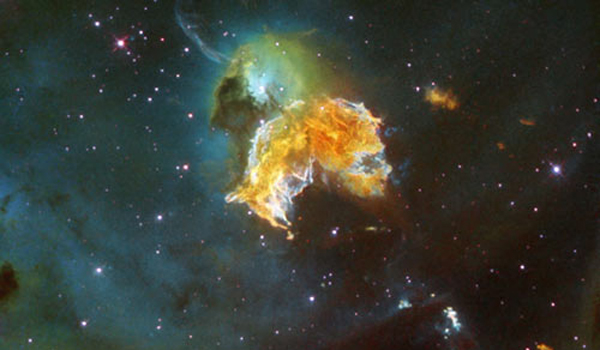Sky 'Crucifix' in Ancient Text May Be Mystery-Solving Supernova

According to an Old English manuscript chronicling the history of the Anglo-Saxons, a mysterious "red crucifix" appeared in the "heavens" over Britain one evening in A.D. 774. Now astronomers say it may have been the supernova explosion that sprinkled unexplained traces of carbon-14 in tree rings that year, halfway around the world in Japan.
Jonathon Allen, an undergraduate student at the University of California, Santa Cruz, made the connection this week after listening to a Nature podcast. He heard a team of Japanese scientists discussing new research in which they measured an odd spike in carbon-14 levels in tree rings from the year A.D. 774 or 775. They thought the spike must have come from a burst of high-energy radiation striking the upper atmosphere and triggering an increase in the rate of carbon-14 formation.
(Carbon-14, a radioactive version of a carbon atom with six protons and eight neutrons, forms when gamma rays from space strip atmospheric atoms of their neutrons, which then collide with the isotope nitrogen-14 and cause it to radioactively decay into carbon-14.)
But a mystery was afoot: the scientists could not find any records indicating a massive supernova (stellar explosion) or solar flare was observed in the skies in the A.D. 770s, and the event would have had to be visible to produce a sufficiently large influx of radiation. [Are We Really All Made of Stars?]
Allen, a biochemistry major with an interest in history, became intrigued. According to Nature News, he did a quick Google search, and came across an English translation of the Anglo-Saxon Chronicle, a history of England written in the ninth century, with this line in the entry for A.D. 774: "This year also appeared in the heavens a red crucifix, after sunset."
"It made me think it's some sort of stellar event," Allen was quoted as saying in Nature. He thought the evening sky object's red color might indicate that it was shrouded by a dust cloud, which would have scattered all but a small amount of red light. Such a cloud might also prevent remnants of the proposed supernova from being visible to modern astronomers.
The connection is plausible, according to Geza Gyuk, an astronomer at Chicago's Adler Planetarium in Illinois, who has used the Anglo-Saxon Chronicle to investigate past astronomical events. "The wording suggests that the object was seen in the western skies shortly after sunset. That would mean that it would have moved behind the sun [where it could not be seen] as Earth orbited the sun," Gyuk told Nature. "That, along with the dimness of the 'new star' due to dust would go a long way to explaining why no one else would have seen or recorded the event."
Sign up for the Live Science daily newsletter now
Get the world’s most fascinating discoveries delivered straight to your inbox.
However, connections between the scientific and historical records are seldom watertight; the "red crucifix" could have been something else entirely. Past astronomers have attempted to explain the chronicle entry as an early description of the Northern Lights, or an optical effect caused by light glinting off high-altitude ice particles, creating both vertical and horizontal bands of light.
This story was provided by Life's Little Mysteries, a sister site to LiveScience. Follow Life's Little Mysteries on Twitter @llmysteries. We're also on Facebook & Google+.










